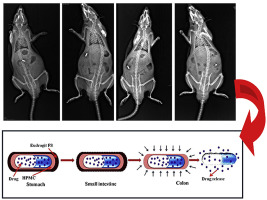Abstract
The objective of this study was to evaluate the combination of pH-dependent and time-dependent polymers on drug release in order to optimize coating for colonic delivery. Response surface methodology (RSM) based on central composite design (CCD) was employed for formulation optimization. Theophylline was used as model drug and Eudragit® FS 30D and hydroxypropyl methylcellulose (HPMC) were used as pH-dependent and time-dependent polymer, respectively. Dissolution test was carried out using the release conditions as follow: pH 1.2 for 2 h, pH 6.8 for 2 h, pH 7.4 for 3 h and pH 6.8 for 3 h. Scanning electron microscopy (SEM) was applied to observe the morphology of coated capsules. Drug release was evaluated spectrophotometrically. In vivo X-ray imaging study was used to trace the movement and behavior of the capsules in gastrointestinal (GI) tract. The optimized formulation containing 0.5% HPMC and 80% Eudragit FS 30D was prepared according to the software determined levels. There was no drug release for 2 h at pH 1.2 and for 2 h at pH 6.8. Optimum values of drug release were 32.57% and 71.37% at pH 7.4 (7 h) and pH 6.8 (10 h), respectively, which were in agreement with the predicted value by RSM. Surface coated capsules were rougher than gelatin capsules as examined by SEM. X-ray analysis confirmed that coated capsules dissolved at the targeted colon region. The results of this study indicate that the designed system can be potentially used as a carrier for colon delivery of drugs.


